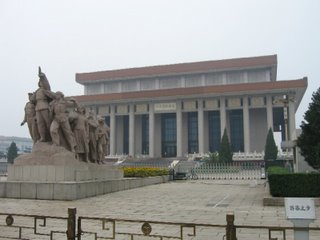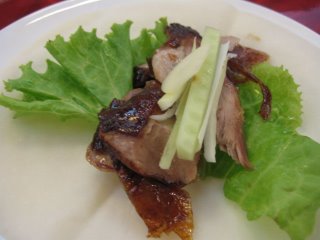-----------
I was sitting on the upper deck of an Air China 747, peering into the massive bird’s cockpit. I had just spent the past two weeks trying desperately to communicate important technical subtleties to my Chinese associates, only to find that there were significant misunderstandings despite my best efforts. Conversations frequently went something like “So when can you have this completed?” followed by the answer of “Yes, no problem.” At this particular moment, I was trying not to think about how the Chinese pilot may have received his flight training, from whom, and if he understood everything clearly. I was also thinking about how I would have preferred to have some company on this part of the trip instead of flying solo. A small part of me thought that I would be very glad when my Beijing adventure was over and I was on my way home.
The flight from Shenzhen to Beijing was completed without incident.
When I got off the plane, the first thing I noticed was the heat. Despite the overcast sky (mix of thick smog and clouds), the temperature and humidity were oppressive. Navigating the airport was not as straightforward as I expected, but eventually I found my way to the bus ticket counter and purchased a ticket for the bus that (I hoped) would bring me into downtown where I could hook up with a subway station. After a half hour ride, I arrived at my stop and got out. Funny thing was, I didn’t see any subway station where I was. Just lots of Chinese people walking and riding bicycles. Most of them seemed to be heading in one particular direction, so I decided to go that way too. Its amazing how you can be surrounded by thousands of people, and yet still be completely and utterly alone. Here I was in Beijing with no one to meet me, no one to help guide me around, and no one to talk to. Wherever I went I was completely conspicuous with my white skin and round eyes (not to mention that I was tall at 5’11”). No one had my back. I was truly alone and I could feel it in my bones. A couple of blocks later, I spotted something that looked suspiciously like a set of stairs heading underground – the Dongzhimen subway station.
In my haste, I had forgotten to print out directions to the hotel, a map, or even just the Chinese characters for the name. All I knew was the street address. I had remembered reading online that it was 0.12 miles away from a subway stop, but I wasn’t sure which one. I was hoping that I could recognize the name when I looked at the subway map. Hmmm….. Fuchengmen sounded familiar, so let’s give that a whirl, I thought.
The Beijing subway was clean and cheap, but modern it was not. In many ways it reminded me of the T in Boston. The stations were old and devoid of air conditioning (did I mention that it was hot?). The train cars were cooled, fortunately. On the door, there was a sign that I assumed said something like “Keep your hands away from the door.” There was a graphic of a hand with the index finger outstretched with a bleeding flesh wound. Let’s not be overly dramatic or anything…
I got off on what I thought was the right stop and I went to find the map. There it was, clearly labeled “Map of Fuchengmen Station.” That’s great, but that was the only English on the entire map! All the street names were in Chinese characters only, all the points of interest too. As little Mandarin as I speak, I can read even less. But of the 4 characters in the street name I was searching for (Beilishilu), I happened to know 3. Ah – here was one that read “Bei-something-shilu.” Hope that one I don’t know is “li.” I headed up to street level and walked that way. Not even 100 yards from the station, there it was. And only one block up from there was my hotel. Boo yah!
I walked into the lobby and felt a huge sense of relief, almost like an undercover CIA agent who has just reached a safehouse. The Holiday Inn Downtown Beijing was clean, cheap, safe, and the staff spoke English. But it was definitely not as nice as it looked on the web. Oh well, I was more than happy to be there, and I didn’t plan on spending much time there anyways.
I quickly tossed my stuff into the room and headed back out. I jumped back on the subway and took a quick ride to Qianmen (literally, Front Gate) where I got out and entered Tiananmen Square, the largest public square in the world. I don’t really know how to describe the scale of this place. I could tell you that it’s 880 meters long by 500 meters wide (that’s over 4.7 million square feet, the equivalent of about 82 football fields), but that only begins to pass along the sensation of standing there. The layout is stark – no trees, benches, or grass. The only structures rising above the pavement are the lampposts, the Monument to the People’s Heroes, and the Mausoleum housing Mao Zedong’s preserved body. Many families were out strolling through the square. Several children were flying kites. Although famous throughout most of the world as the site of pro-democracy demonstrations in 1989, the history of this place is unknown to many Chinese due to government censorship (for a good primer on these events, read this short write-up - it’s a good commentary on the culture of the current Chinese government). It was an eerie feeling to be standing in a place of such dubious historical significance.

Qianmen - the first of the 3 main gates of ancient Beijing
About 25% of the square is visible in this photo
The Mausoleum where Mao is on display. No cameras allowed inside.
The Chinese flag, flying high over Tiananmen Square
I made my way through the square, shooing away many “art students” wanting me to buy their paintings, and crossed Changan Road to the Tiananmen, which means, Gate of Heavenly Peace (ironic, isn’t it?). Through this gate is the Meridian Gate, which is the front entrance to the Imperial Palace, or Forbidden City (more on that later).

A lion guards Tiananmen
Looking through Tiananmen to the Meridian Gate. Notice the people touching the brass knobs on the door for luck.
Some Chinese soldiers marching towards Tiananmen Square to do... something
Since it was too late to get in the Forbidden City, I walked around the outside of it, through some special Beijing streets and neighborhoods known as Hutongs. A Hutong is a long, narrow street with courtyard style residences. Some have roads only 3 feet wide! These places are old, and represent a vanishing way of life. Many have been destroyed to make way for new roads or high rises. Fortunately, some have been protected by the government, although it is still common to see bulldozers clearing them out.

The destruction of Hutongs is, unfortunately, a common sight
After a few miles of walking, I had made my way over to the east side of downtown where I found the Donghuamen night market – the perfect place to grab a snack.
I’m usually the guy who says he’ll try anything. This place really holds your feet to the fire on that one. Stall after stall of all manner of – things – on skewers, ready to grill to order. There was not a single item above $2. I could describe the things I saw there to you, but the impact is more visceral if you click on the photo below and see for yourself. Go ahead… Just do it already!
I have to say, if I was with some friends and someone said, “Hey, let’s all get scorpion kebobs!” and then they actually did, I would have to eat one. So there, I guess I would try this stuff. Well, maybe not the grubs. Or the centipedes. The locusts would be tough too. How are you supposed to eat the starfish anyways? It just so happened that on this particular day, I had a genuine reason to pass up the opportunity to sample these delicacies. The following day I had a date with the Great Wall (6 hours on a bus and 4 hours hiking, with no facilities available). I couldn’t afford the need to be chained to the thunder bucket all day. Yeah, that’s my story and I’m sticking to it.
Instead, I opted for the more civilized option – The world famous Quanjude Roast Duck Restaurant. No, no, no, no. Not like that, you’ll sound like an idiot. It sounds something like Chuan-jyu-duah. It’s world famous you know. I skipped the mustard duck webs and stir fried duck tounges and went straight for the “Masterwork Duck,” along with a side of braised Chinese cabbage with chestnuts.

The skill of the master carver on display, tableside

Now that's how you make duck. Absolutely brilliant.
I spent the rest of the evening shopping on Wanfujing Avenue, which has a huge variety of plazas, restaurants, and shops, including many high end Western stores. After picking up a couple of cheap souveniers, I hit the subway and headed for “home.” My head hit the pillow and I crashed for the night. I would need my rest – tomorrow was going to be a big day.




No comments:
Post a Comment